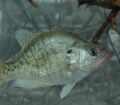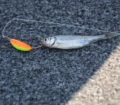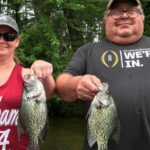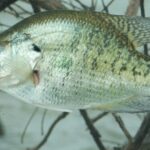 Editor’s Note: Are you tired of going fishing and not catching any crappie? Would you like to eliminate some of the guesswork from finding and taking crappie? Would you like to know the secret haunts and specialized techniques that will help you take speckled sides on every outing? Crappie-fishing guides and tournament crappie pros must find and take papermouths every day they’re on the water. They’ve unlocked many of the mysteries crappie have held beneath the surface for years, and this week we’re covering some of their most-productive tactics.
Editor’s Note: Are you tired of going fishing and not catching any crappie? Would you like to eliminate some of the guesswork from finding and taking crappie? Would you like to know the secret haunts and specialized techniques that will help you take speckled sides on every outing? Crappie-fishing guides and tournament crappie pros must find and take papermouths every day they’re on the water. They’ve unlocked many of the mysteries crappie have held beneath the surface for years, and this week we’re covering some of their most-productive tactics.
Some crappiers are convinced that barometric pressure and weather determine where the crappie will be, and how they will bite. Just ahead of a cold front, crappie usually will bite better. But when a high front moves through after a cold front, perhaps a crappie’s balance may be off somewhat, and the fish tend not to bite as well. Generally the crappie will go into the deeper water and hold up against the brush. Maybe the fish are attempting to stabilize themselves in the water.
 If that cold front hits during the spawn, crappie will move out into the deeper water and hold in the places where you’ve found them during the pre-spawn and often where they’ll be in the post-spawn – in about 8 – 10 feet of water. One of the best baits to use at this time of the year during a cold weather front is minnows, since minnows will move in the brush without you’re actually having to move them. When fishing jigs, cast a 1/32-ounce jig in close to the cover and retrieve it slowly on a spinning reel mounted on a graphite rod. As the line on the reel comes back, allow the line to just barely touch your index finger, which causes the jig to twitch just a little as it’s being retrieved. That erratic motion, although small, gives the jig a more life-like action and will make tight-lipped crappie bite. Many anglers fish 1/32-ounce jigs year-round for crappie.
If that cold front hits during the spawn, crappie will move out into the deeper water and hold in the places where you’ve found them during the pre-spawn and often where they’ll be in the post-spawn – in about 8 – 10 feet of water. One of the best baits to use at this time of the year during a cold weather front is minnows, since minnows will move in the brush without you’re actually having to move them. When fishing jigs, cast a 1/32-ounce jig in close to the cover and retrieve it slowly on a spinning reel mounted on a graphite rod. As the line on the reel comes back, allow the line to just barely touch your index finger, which causes the jig to twitch just a little as it’s being retrieved. That erratic motion, although small, gives the jig a more life-like action and will make tight-lipped crappie bite. Many anglers fish 1/32-ounce jigs year-round for crappie.
Crappiers also seem to prefer 4-pound-test line and light rods, because you can cast the jigs further using this pound test line and a light-action rod. Although crappie are harder to catch in deep water, like 25-feet deep, often the crappie there are larger fish. Since jigs are more difficult to see at that depth because of  light penetration, when fishing deep, often anglers fish chartreuse jigs to be seen by the crappie at greater depths. In clear water, some prefer to fish light-colored jigs like tan-and-white, yellow-and-white or even smoke-colored or transparent jigs. If the water’s stained, you may choose either chartreuse, red-and-chartreuse and/or black-and- chartreuse or maybe even orange with a yellow tail. Matching the water condition and water depth to the color of jig you fish is very important if you want to catch more and bigger crappie.
light penetration, when fishing deep, often anglers fish chartreuse jigs to be seen by the crappie at greater depths. In clear water, some prefer to fish light-colored jigs like tan-and-white, yellow-and-white or even smoke-colored or transparent jigs. If the water’s stained, you may choose either chartreuse, red-and-chartreuse and/or black-and- chartreuse or maybe even orange with a yellow tail. Matching the water condition and water depth to the color of jig you fish is very important if you want to catch more and bigger crappie.
 To learn more about crappie fishing, check out John E. Phillips’ book, “Catch Crappie All Year: Fishing a Single Pole, Using No Boat and Farming Crappie,” available in Kindle, print and Audible versions at https://www.amazon.com/Catch-Crappie-All-Year-Fishing-ebook/dp/B00VO0DZTI.
To learn more about crappie fishing, check out John E. Phillips’ book, “Catch Crappie All Year: Fishing a Single Pole, Using No Boat and Farming Crappie,” available in Kindle, print and Audible versions at https://www.amazon.com/Catch-Crappie-All-Year-Fishing-ebook/dp/B00VO0DZTI.










